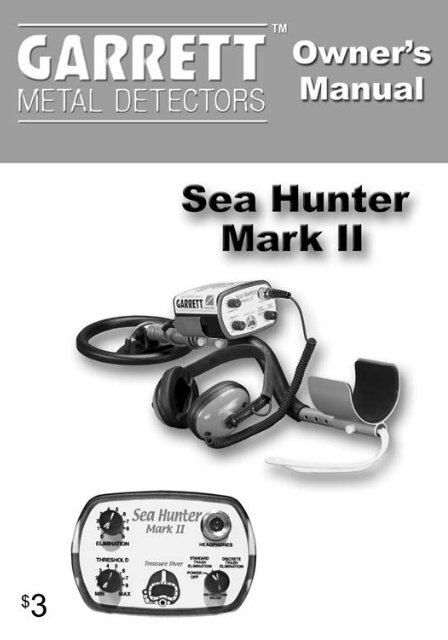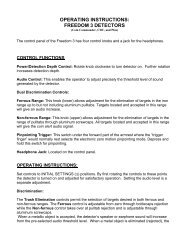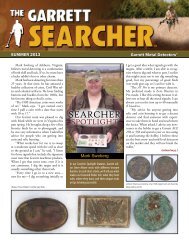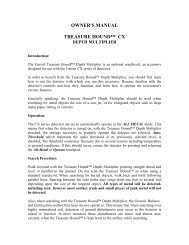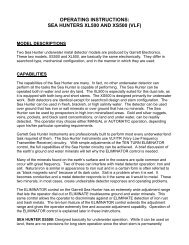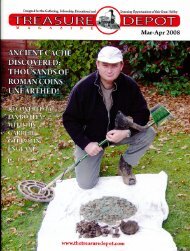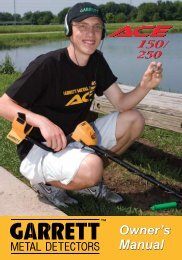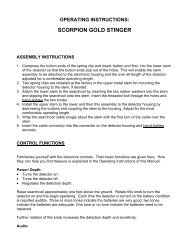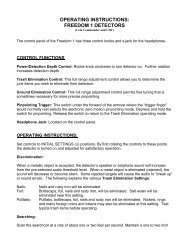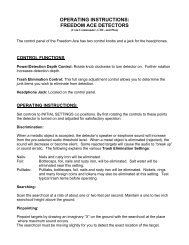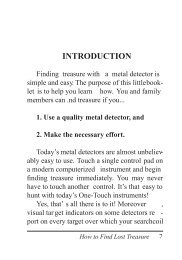garret sea hunter mark ii - Garrett
garret sea hunter mark ii - Garrett
garret sea hunter mark ii - Garrett
Create successful ePaper yourself
Turn your PDF publications into a flip-book with our unique Google optimized e-Paper software.
TABLE OF CONTENTSTo the Owner 4Control Functions 6Search Modes 8Assembly 13Operating Procedure 17Field Recommendations 18Search and Recovery Tips 20Cautions 25Maintenance 27Battery Replacement 28Recommended Accessories 30Specifications 31Repair Service 32Warning 34Recommended Reading 35Mind Your Manners 37RAM Book Order Form 39
to the ownerThe <strong>Garrett</strong> Sea Hunter Mark II has anunparalleled reputation among treasure<strong>hunter</strong>s, law enforcement agencies andvarious industries as one of the mostreliable and sophisticated submersiblemetal detectors of its kind.The Sea Hunter Mark II is an advancedmicroprocessor-driven instrument that islightweight, highly durable and easy touse. The Sea Hunter's pulse induction(PI) circuitry provides excellent depthand enables you to find treasure withoutinterference from salt water and mostground minerals.Outstanding FeaturesThe Sea Hunter's outstanding performance,custom-designed housing and multipleconfigurations make it superior toother underwater detectors available.Microprocessor-based circuitry in the SeaHunter provides greater sensitivity, fastertarget response and comes with <strong>Garrett</strong>'s
exclusive Discrete Target Eliminationmode. The custom designed doubleo-ring<strong>sea</strong>led housing is durable andlightweight, with individual, o-ring <strong>sea</strong>ledbattery and electronics compartments thatmakes battery replacement hassle free.An 8" epoxy-filled <strong>sea</strong>rchcoil and customdesigned headphones, submersible to 200feet, make the Sea Hunter Mark II highlystable and reliable.The Sea Hunter Mark II is very versatile,offering four stem arrangements to suityour <strong>sea</strong>rch needs: the long stem with topstem mount, under cuff stem mount, hipmount and the short stem ScubaMate.Each arrangement allows you the versatilityto <strong>sea</strong>rch on land, in shallow water orunderwater, or in situations where a <strong>sea</strong>leddetector is required. The ScubaMate isideal for diving while the long stem allowsyou to carry the control housing on yourwaist or shoulder, or stem mounted, isuseful for <strong>sea</strong>rching on land or in shallowwater.
Control FunctionsFigure 1, Panel FacePower - Use to turn the detector on andchoose either of two <strong>sea</strong>rch modes. Abattery check occurs automatically eachtime the power is switched on. (Figure 1)Threshold - Use to set the base audiolevel according to an individual's hearingability and how loud the outside noiseis. Typically the sound is set no louderthan necessary, just above silent isrecommended. (Figure 1)
Elimination - Use in conjunction witheither the Standard or Discrete TrashElimination modes to choose theelimination level appropriate to your<strong>sea</strong>rch needs. As the elimination knob isrotated clockwise, an increasing numberof undesirable items are excluded fromdetection. (Figure 1).
Search ModesStandard Trash Elimination and DiscreteTrash Elimination are the <strong>sea</strong>rch modesavailable with the Sea Hunter Mark II. Theselector switch for these modes is locatedon the right side of the panel.Standard Trash Elimination is the <strong>sea</strong>rchmode normally available on conventionalpulse induction (PI) metal detectors. Thebackground audio threshold is continuousand remains close to the operator'schosen level while responding to ongoingvariations in the detection signal. Small ordeep targets produce faint, weak signalsand large or shallow targets produceloud, strong signals.The elimination knob is used to change thedetector's ability to detect various typesof metal. As you rotate the eliminationknob clockwise, the detection response tometals decreases. The detection responseto poor conductors, such as foil, nickel andpull tabs decreases significantly more than
the response to good conductors such ascoins and fine jewelry. In Standard mode,the response to poor conductors can beeliminated effectively; however, if theseobjects are too close to the <strong>sea</strong>rchcoil,a detection response may occur. Theresponse to good conductors, althoughsomewhat diminished, remains relativelystrong. Some jewelry such as rings andthin gold necklaces are found in themiddle of the conductivity range, so it'simportant to dial in only the amount ofelimination needed for the <strong>sea</strong>rch area.Standard mode permits a very slow<strong>sea</strong>rchcoil sweep, making it particularlyeffective for pinpointing targets. It providesthe deepest possible detection and ismost useful in areas with little trash.Discrete Trash Elimination is a <strong>sea</strong>rchmode exclusive to the Sea Hunter MarkII. It is similar in operation to detectorswith a Motion Discrimination mode in thatit provides more precise and enhanced
(Standard Mode with elimination at0) metals can be detected at 100%capability. As the elimination control isincreased in either <strong>sea</strong>rch mode, theresponse to various targets decreases.Note that the response to many metalsdecreases more rapidly in Standardmode than in Discrete mode.As with Standard mode, the eliminationknob is used to change the detector'sability to detect various types of metal;poor conductors can be eliminated whileonly slightly reducing the detection ofbetter conductors. Although Discretemode appears to achieve less detectiondepth in air tests, its ability to eliminateundesirable items precisely, withoutaffecting desirable items, enable it tooutperform Standard mode in certainsituations. For example, when theelimination control is set to exclude pulltabs, it excludes pull tabs with little or noeffect on the detection response to mostthin gold rings (Figure 2).11
12To pinpoint in Discrete mode, you simplysweep the <strong>sea</strong>rchcoil from to side to sideover a target. The <strong>sea</strong>rchcoil must remainin motion to produce a detection response.This mode is designed to provide superiorpulse induction target discrimination andis extremely effective in areas with lotsof trash.
Assembly1. Choose a desired operating / stem /control housing configuration. Assemblethe stem and attach the control housingas desired. (Figure 3,4,5).Figure 3, ScubaMateFigure 4, Full length with undercuff13
14Figure 5, Long stem with hip mount configurations
Figure 6, Parts needed to assemble stem and <strong>sea</strong>rchcoil2. Attach the <strong>sea</strong>rchcoil to the lowerstem. Align the mounting holes of the<strong>sea</strong>rchcoil and stem, insert the threadedbolt through the holes and hand-tightenthe knobs; Do Not use tools. (Figure 6)3. Wrap the cable around the stemand secure it according to youroperating configuration. For a hip mountconfiguration, use the adjustable strap tosecure the cable to the upper stem.15
4. Ensure the <strong>sea</strong>rchcoil connector atthe rear of the control housing is cleanand the o-ring is well lubricated; add alittle silicon grease or petroleum jelly ifnecessary. Do not coat connector pinswith lubricant. Insert coil connector andgently hand tighten. Do not over tighten.5. Repeat Step 4 when assembling theheadphone connector at the front of thecontrol housing.6. Perform a battery test by switching onthe detector, noting the number of beepsthat occur. Scan a metal object to confirmdetection. If the batteries are low or thedetector fails to operate, verify that thebattery pack and batteries are alignedproperly.16
Operating Procedure1. Switch on the detector and note theresults of the battery test represented bya range of one to four beeps. Four beepsindicate the batteries are full, one beepindicates they must be replaced.2. Select the Standard or Discrete TrashElimination mode.3. Set the threshold knob to the desiredaudio level. Typically the audio is set verylow; usually just above silent. How lowyou set it depends on your hearing needsand how loud the background noise is.4. Set the elimination control to zeroor a low level until you examine your<strong>sea</strong>rch area and determine the kinds ofmetal items you want eliminated fromdetection. Then re-adjust it to a level thatmaximizes your <strong>sea</strong>rch goals.17
18Field RecommendationsKnowing the conditions of your <strong>sea</strong>rchand which items you want, or don't want,to find will help you choose the <strong>sea</strong>rchmode and elimination setting which bestsuits your needs.Depending on your <strong>sea</strong>rch goals, youmay want to set the elimination no higherthan necessary so that you can detectmost metals. You may even want to setthe elimination at zero so there is nodiscrimination and all metals are detected.Although you'll detect a lot of undesirableitems like foil and pull tabs, you won'tmiss any desirable ones.Methodically sweep the <strong>sea</strong>rchcoilfrom side to side keeping it one or twoinches above the surface. Restrict yoursweeping speed to about one to twofeet per second. Overlap each sweepby advancing the <strong>sea</strong>rchcoil by at leasta quarter of its diameter; one half isrecommended. Always scan in a straight
line (not a wide arc); it helps keep the<strong>sea</strong>rchcoil level, reduces the likelihood oflifting the <strong>sea</strong>rchcoil at the end of eachsweep and ensures the overlap sweepsremain uniform.Finally, it is important to remember thatany detection signal, no matter howloud or faint, represents the sound ofmetal and its source should always bedetermined.As with all PI detectors, eliminating ironmaterials while in either mode is difficultif not impossible. However, attaching amagnet to the inside of your digging toolcan help separate bits of iron and otherdebris from your treasure finds.19
Search & Recovery TipsTreasure HuntingRe<strong>sea</strong>rch - The first rule of successful treasurehunting, whether on land or in the <strong>sea</strong> is to doyour homework. Learn as much as you canabout the areas you want to <strong>sea</strong>rch, the kindof treasure you want to find and the best waysto recover it. The better prepared you are thegreater your chances for success. The followingbooks by Charles <strong>Garrett</strong>, available from <strong>Garrett</strong>Metal Detectors, or your local Authorized <strong>Garrett</strong>Dealer, offer invaluable re<strong>sea</strong>rch, advice anddetailed information on <strong>sea</strong>rch and recoverytechniques for hobbyists: How to Search Sandand Surf;Treasure Hunting for Fun and Profitand New Successful Coin Hunting.Search popular gathering places - Survey thebeach to determine areas with lots of peopleactivity. A wealth of treasure, including lostcoins and jewelry, often lies hidden beneaththe sand. Other areas that can yield treasureinclude footpaths, scenic spots, picnic or campsites, concession stands, dressing cabins,water fountains, boat docks, boardwalks, <strong>sea</strong>20
wall bases, bridges, channel-dredgingsites and sunken vessels.Study surf and weather patterns -Pay attention to storm, wind and tideactivity. Treasures from deepwatervaults are often transferred to shallowerlocations like tidal pools and water-filleddepressions near the shoreline. A beachconsidered unproductive can suddenlyyield riches. Heavy storm waves oftenunearth treasures like rings caught inexposed rock and gravel areas. (Figure7).Figure 7, Surf Pattern21
materials of unwanted or hazardous metalitems. Metal detectors have been usedto find a variety of hidden items, suchas pipes, scrap metal, nails embeddedin lumber, underground electrical powercables and oil barrels.Select zero discrimination - When usedfor the purposes of law enforcement orindustry, the Sea Hunter Mark II, or anymetal detector for that matter, usuallyrequires little or no discrimination.Underwater <strong>sea</strong>rches - The Sea HunterMark II can locate both ferrous andnon ferrous metals concealed within andbelow aquatic growth from bottom soiland rocks, wood and other non-metallicmaterials. Large items such as boats,motors and safes can be located severalfeet below the <strong>sea</strong>rchcoil. Locatingsmall, isolated items is more difficult andrequires a comprehensive grid <strong>sea</strong>rchwith the detector.23
24Land <strong>sea</strong>rches - When <strong>sea</strong>rching nearwire fences, metal buildings, etc., makesure that you scan the <strong>sea</strong>rchcoil parallelto the structure.
Cautions1. To avoid acid damage you shouldinstall high-quality alkaline or nickel metalhydride batteries and always removethem prior to storing the detector.2. If the battery compartment becomesflooded, remove the batteries immediately,rinse the compartment with fresh waterand allow to air dry. The electronicscompartment is factory <strong>sea</strong>led andshould never be opened. The seethrough"helmet mask" window on thefront panel should remain clean and freefrom condensation. If the window everdisplays moisture, you should contact the<strong>Garrett</strong> factory as soon as possible.3. Before diving, always examine the<strong>sea</strong>rchcoil and headphone connectorsand battery cap. Verify the batterystrength by operating the detector for acouple of minutes prior to field use.25
4. Dive with extreme caution. Observediving practices to lessen the risk ofbecoming entangled with the headphonesor coil cables. Ensure that the headphones'vent holes are open prior to diving.5. When using the hip mount configuration,ensure that the belt will not interfere withequipment removal in the event of anemergency.26
Maintenance1. Wash off any sand, salt and residuefrom the detector immediately after eachuse.2. Avoid high, internal temperatures byprotecting the equipment from the sun.Store equipment in a cool location; avoidstorage in a hot vehicle.3. Take advantage of <strong>Garrett</strong>'s preventativemaintenance program. For a small fee,the factory will inspect the entire detector,replace its <strong>sea</strong>ls and pressure test it.Contact the factory for more details.27
Battery replacement28Figure 8, Proper battery pack re-installationTo access the battery pack, unscrew thebattery cap at the rear of the detectorhousing, by hand. Do not use tools.The o-ring should remain in the controlhousing while the battery pack slidesout. When installing batteries ensure thatthey are aligned with the correct polarity(plus and minus) <strong>mark</strong>ings. Re-install thebattery pack by placing the contact endof the housing inside first and pointingdownward (figure 8). Verify that the o-ringis well-lubricated and free from debris.Add a little silicon grease or petroleum
jelly, if necessary. Reinstall the batterycap, hand tighten it until it is flush withthe housing and the two index <strong>mark</strong>s arealigned as shown (Figure 9).Figure 9, Proper battery cap re-installation29
Recommended AccessoriesUsing the right recovery tools is asessential to treasure hunting as thedetector itself. Here are a few examplesof recovery tools and their uses (Figure10).A hand scoop is useful for dry sand andshallow water recovery up to two feet.A trowel is best for recovering items inclay or gravel areas.Figure 10, Various commercially available recovery toolsTip: A strong magnet attached to the inside of a scoop willhelp separate bits of wire and other iron debris from yourtreasure finds.30
Specifications• Circuit type: Pulse Induction, automaticcancellation of salt/iron mineralization.• Frequency: 750 pulses per second• Submersion depth: Up to 200 feet (65meters) or seven atmospheres• Buoyancy: Near neutral• Batteries: Eight "AA"• Battery life: Approximately 18-22 hours• Control housing weight: 31 oz.• Headphones: 11 oz.• Sea Hunter Mark II with ScubaMate, noheadphones: 64 oz.• Sea Hunter Mark II with long stem, noheadphones: 73 oz.31
Repair ServiceIf you have difficulty operating the SeaHunter Mark II, take a few minutesto re-read this manual and check thebatteries, switches and connectors. If youare unfamiliar with underwater detectors,consult your local Authorized <strong>Garrett</strong>Dealer or the <strong>Garrett</strong> factory.If your Sea Hunter needs repair, you shouldreturn it to the factory accompanied by adetailed letter describing the problem(s).Carefully pack the detector in its shippingcarton or other sturdy box, using packingmaterial or appropriate insulation toprotect the parts. Do not include thestems or headphones unless they arepart of the problem. Return all coils,unless the problem is mechanical.Note: Remember to include your name,address and daytime phone number withyour shipment.32
Return your detector to:<strong>Garrett</strong> Metal Detectors1881 W. State St.Garland, Texas 75042Please allow one week from the receiptdate for the detector's inspection and/orrepair and another week for its return.<strong>Garrett</strong> will automatically return thedetector via UPS or Parcel Post unlessyou provide a written authorization thatinstructs otherwise.More InformationFor further assistance, please contact the<strong>Garrett</strong> Customer Service Department, at1.800.527.4011 or 972.494.6151.33
WarningThe following measures must be observedat all times.Do not hunt in areas where electric lines,gas/water pipelines, bombs or otherexplosives may be buried.Never trespass or hunt on private propertywithout permission.National and state parks, monuments,military sites, etc. are absolutely "offlimits".Always exercise caution when diggingtoward a target where the undergroundconditions are unknown.34
Recommended ReadingThere are a variety of books availablefrom <strong>Garrett</strong> that can teach you how touse a metal detector effectively, giveyou ideas about places to hunt and helpimprove your <strong>sea</strong>rch and recovery skills.(All books are written by Charles <strong>Garrett</strong>unless specified otherwise.)The revised classic, Modern MetalDetectors, is a book that providesnecessary, basic information on metaldetectors and their use.The latest edition of Treasure Huntingfor Fun and Profit is written especially forbeginner hobbyists.Looking for interesting places to hunt?Why not check out Charles <strong>Garrett</strong>'sbook, Ghost Town Treasures, or BobMarx's Buried Treasures You Can Find,a book describing countless sites wheretreasure is believed to exist.35
36New Successful Coin Hunting, You CanFind Gold with a Metal Detector and HowTo Search Sand and Surf are perfectbooks for readers who have specifichunting goals.
Mind Your MannersFilling holes and obeying NOTRESPASSING signs are just two ofthe responsibilities of a dedicated metaldetector hobbyist. The sincere requestthat Charles <strong>Garrett</strong> makes to everyonewho uses his equipment is to leave eachplace they <strong>sea</strong>rch in better condition thanthey found it. Thousands of individualsand organizations have adopted thisformal Code of Ethics for Metal DetectorOperators:• I will respect private and public property,all historical and archaeological sitesand will not metal detect on these siteswithout proper permission.• I will keep informed and obey all laws,regulations and rules governing federal,state and local public land.• I will aid law enforcement officialswhenever possible.37
• I will not willfully cause damage to property,including fences, signs and buildings and I willalways fill the holes I dig.• I will not destroy property, buildings, or theremains of ghost towns and other desertedstructures.• I will not leave litter or uncovered items lyingaround. I will carry all trash and discardedtargets with me when I leave each <strong>sea</strong>rcharea.• I will observe the "Golden Rule" using goodoutdoor manners and conducting myself at alltimes in a manner that will enhance the publicimage of everyone involved in the field of metaldetection.38
RAM BOOKS ORDER FORMPlease send me the following RAM books:(Please indicate number of copies desired.)___ New Successful Coin Hunting................... $9.95___ Treasure Hunting for Fun and Profit......... $9.95___ Treasure Caches Can Be Found................ $9.95___ Ghost Town Treasures................................ $9.95___ You Can Find Gold with a Metal Detector.... $9.95___ Buried Treasures You Can Find............... $14.95___ Gold of the Americas................................. $9.95___ New Modern Metal Detectors................. $12.95___ Gold Panning is Easy................................ $9.95___ How to Find Lost Treasure*...................... $3.95___ How to Find Gold...................................... $3.95___ How to Search Sand and Surf.................... $3.95* Free with the purchase of any other RAM book or<strong>Garrett</strong> product. If you do not wish to purchase anything butwould like a free copy of How to Find Lost Treasure, mail $2.00for postage and handling to the address below. U.S. orders only.For international orders, contact international@<strong>garret</strong>t.com.Please send payment to:RAM Publishing Co.1881 West State StreetGarland, Texas 75042(Order form continued on back of this page)39
MAIL-IN ORDER FORMAdd $2.00 for first book, and $1.00 for each additional bookordered for handling and shipping charges.Total for books$______________8.25% Tax (TX/CA residents) $______________Handling ChargeTOTAL$______________$______________Payment Options:___ Enclosed check or money order___ I prefer to order through:___ American Express ___ MasterCard___ Visa___ DiscoverCard Number: ______________________________Expiration Date of Card: _____________________Phone Number: ____________________________Signature: _________________________________Required on credit card purchasesName: ____________________________________Address: ____________________________________________________________________City/State/Zip: _____________________________40
Patent protection<strong>Garrett</strong>'s high tech instruments areprotected by one or more of thefollowing United States Patents andother Patents Pending: 4,398,104,4,423,377, 4,303,879, 4,334,191,3,662,225, 4,162,969, 4,334,192,4,488,115, 4,700,139, 4,709,213,Design 274,704 and 297,221G. B. Design 2,011,852Australia Design111,674.Other patents pending.All <strong>Garrett</strong> detectors are manufacturedin the United States of America.© 2008 <strong>Garrett</strong> Metal DetectorsAll rights reserved.41
1881 W. State StreetGarland, Texas 75042Toll Free:1.800.527.4011Tel: 972.494.6151Fax: 972.494.1881Email: sales@<strong>garret</strong>t.com© 2008 <strong>Garrett</strong> Electronics, Inc.PN 1525400.D.0408


